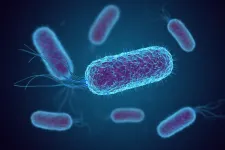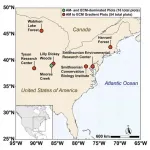Specific bacteria in the gut prompt mother mice to neglect their pups
Salk researchers make unexpected discoveries about how a particular microbe influences animal behavior
2021-01-29
(Press-News.org) LA JOLLA--(January 29, 2021) As scientists learn more about the microorganisms that colonize the body--collectively called the microbiota--one area of intense interest is the effect that these microbes can have on the brain. A new study led by Salk Institute scientists has identified a strain of E. coli bacteria that, when living in the guts of female mice, causes them to neglect their offspring.
The findings, published January 29, 2021, in the journal Science Advances, show a direct link between a particular microbe and maternal behavior. Although the research was done in mice, it adds to the growing body of science demonstrating that microbes in the gut are important for brain health and can affect development and behavior.
"To our knowledge, this is the first demonstration that the intestinal microbiota is important for promoting healthy maternal behavior and bonding between mom and offspring in an animal model," says Professor Janelle Ayres, Laboratory Head of Salk's Molecular and Systems Physiology Laboratory and senior author of the paper. "It adds to the ever-growing evidence that there's a gut-brain connection, and that microbes are important for regulating the behavior of the host that they're inhabiting."
The ways in which the microbiota can impact mental health and neurological disorders is a growing area of research. The makeup of the gut microbiota in people has been linked to depression, anxiety, autism and other conditions. But it has been difficult to study how individual strains of bacteria exert their influence on human behavior, a connection often called the microbiota-gut-brain axis.
In her lab, Ayres uses mice to study how body systems and the brain interact with each other to promote health. This includes focusing on how body processes are regulated by microbes and the ways in which microbes affect growth and behavior. In the current experiments, she and her team were investigating groups of mice that each had a single strain of E. coli in their gut. Mice with one particular strain of E. coli, called O16:H48 MG1655, mothered offspring that had stunted growth. Further examination revealed that the mice were smaller because they were malnourished.
"We found that the pups' behavior was normal, and the milk made by the mothers was of normal, healthy composition and was being produced in normal amounts," Ayres says. "We eventually figured out that being colonized with this particular bacteria led to poor maternal behavior. The mice were neglecting their pups."
Additional experiments revealed that the mice could be rescued from stunted growth, either by giving them a growth factor called IGF-1 or handing them off to foster mouse mothers that could take care of them properly. This confirmed that the cause of stunted growth was coming from the mothers' behavior rather than something in the pups themselves.
"Our study provides an unprecedented understanding of how the intestinal microbiota can disrupt maternal behavior and how this can negatively impact development of an offspring," says first author Yujung Michelle Lee, a former graduate student in Ayres' lab and now a postdoctoral fellow at Genentech. "It is very interesting to me that establishment of a healthy mother-infant relationship is driven by factors beyond hormones, and that the microorganisms residing in our bodies play a significant role in it."
Ayres and her team plan to study how these microbes provoke changes in mouse behavior. Early findings suggest the bacteria might be affecting levels of serotonin, the hormone associated with feelings of happiness and well-being, but more work is needed.
"It's very hard to study these relationships in humans, because the human microbiota contains hundreds of different species of microorganisms," says Ayres, who holds the Helen McLoraine Developmental Chair. "But once we understand more about the mechanisms in animal models, we may be able translate our findings to humans to determine whether the microbes and their effects might be the same."
The O16:H48 MG1655 strain has been found in human guts and was previously believed to have no positive or negative effects.
INFORMATION:
Other authors on the study were Andre Mu of Salk and Martina Wallace, Jivani M. Gengatharan, Annalee J. Furst, Lars Bode and Christian M. Metallo of the University of California San Diego.
This work was funded by a Crohn's and Colitis Foundation Senior Research Award, National Institutes of Health grant R01 AI114929, and the Lynne and Mason Rosenthal/Leo S. Guthman Foundation.
About the Salk Institute for Biological Studies:
Every cure has a starting point. The Salk Institute embodies Jonas Salk's mission to dare to make dreams into reality. Its internationally renowned and award-winning scientists explore the very foundations of life, seeking new understandings in neuroscience, genetics, immunology, plant biology and more. The Institute is an independent nonprofit organization and architectural landmark: small by choice, intimate by nature and fearless in the face of any challenge. Be it cancer or Alzheimer's, aging or diabetes, Salk is where cures begin. Learn more at: salk.edu.
[Attachments] See images for this press release:

ELSE PRESS RELEASES FROM THIS DATE:
2021-01-29
Boulder, Colo., USA: Sixteen articles were published online ahead of print for GSA Bulletin in January. Topics include insights from the Sawtooth metamorphic complex in Idaho, fingerprinting sand from ancient rivers, eroding Cascadia, and the Troodos ophiolite.
Three-dimensional geometry and growth of a basement-involved fault network developed during multiphase extension, Enderby Terrace, North West Shelf of Australia
Hongdan Deng; Ken McClay
Abstract: Basement fault reactivation, and the growth, interaction, and linkage with new fault segments are fundamentally three-dimensional and critical for understanding the evolution of fault network development in sedimentary basins. This paper analyzes the evolution of a complex, basement-involved ...
2021-01-29
CHICAGO (January 29, 2021) -- Structural racism thwarts a large proportion of black patients from receiving appropriate lung cancer care, resulting in worse outcomes and shorter lifespans than white patients with the disease, according to research presented at the 57th Annual Meeting of The Society of Thoracic Surgeons.
"Many studies have shown that there are disparities between the outcomes of black and white patients, but have done little to elucidate why these disparities are occurring," said Chandler Annesi, a medical student from Boston University ...
2021-01-29
Languages differ in the sounds they use. The Japanese language, for example, does not distinguish between "r" and "l" sounds as in "rock" versus "lock." Remarkably, infants become attuned to the sounds of their native language before they learn to speak. One-year-old babies, for example, less readily distinguish between "rock" and "lock" when living in an environment where Japanese, rather than English, is spoken.
Influential scientific accounts of this early phonetic learning phenomenon initially proposed that infants group sounds into native vowel- and consonant-like phonetic categories ...
2021-01-29
Scientists have given a fascinating new insight into the next steps to develop fast, energy-efficient, future computing systems that use light instead of electrons to process and store information - incorporating hardware inspired directly by the functioning of the human brain.
A team of scientists, including Professor C. David Wright from the University of Exeter, has explored the future potential for computer systems by using photonics in place of conventional electronics.
The article is published today (January 29th 2021) in the prestigious journal Nature Photonics.
The ...
2021-01-29
East Hanover, NJ. January 29, 2021. A team of New Jersey researchers has demonstrated that high-dose therapy gait training using robotic exoskeletons may aid early rehabilitation for acute stroke. The article, "Robotic exoskeleton gait training during acute stroke inpatient rehabilitation" (doi: 10.339/fnbot.2020.581815), was published October 30, 2020 in Frontiers in Neurorobotics is available open access at: https://www.frontiersin.org/articles/10.3389/fnbot.2020.581815/full
The authors are Karen Nolan, PhD, Kiran Karunakaran, PhD, and Kathleen Chervin, of Kessler Foundation, Michael Monfett, MD, of Children's Specialized Hospital, Radhika Bapineedu, MD, and Neil N. Jasey Jr, MD, of Kessler Institute for Rehabilitation, and Mooyeon Oh-Park, MD, ...
2021-01-29
Coronary artery calcification -- the buildup of calcified plaque in the walls of the heart's arteries -- is an important predictor of adverse cardiovascular events like heart attacks. Coronary calcium can be detected by computed tomography (CT) scans, but quantifying the amount of plaque requires radiological expertise, time and specialized equipment. In practice, even though chest CT scans are fairly common, calcium score CTs are not. Investigators from Brigham and Women's Hospital's Artificial Intelligence in Medicine (AIM) Program and the Massachusetts General Hospital's Cardiovascular Imaging Research Center (CIRC) teamed up to develop and evaluate a deep learning system ...
2021-01-29
In the treatment of SARS-CoV-2, the virus that causes COVID-19, antiviral drug remdesivir has emerged as a promising candidate.
Remdesivir works by disrupting the virus's ability to replicate, but its exact mechanism has remained a mystery. Using advanced computational simulations, researchers at the Pritzker School of Molecular Engineering (PME) at the University of Chicago have revealed just how the drug works at the molecular level. They also found that two drugs that work in a similar manner, ribavirin and favilavir, do not bind as effectively to the virus.
"It's important to understand ...
2021-01-29
Researchers at the University of Maryland, Baltimore County (UMBC) have made strides in automated legal document analytics (ALDA) by creating a way to machine-process the Code of Federal Regulations (CFR). The CFR is a complex document containing policies related to doing business with the federal government. All business affiliates of the federal government must comply with the CFR. For government contracts to be equitably open to a broad range of businesses, policies within the CFR must be accessible.
This document automation is just one part of a broader project to help contractors and other entities manage and monitor ...
2021-01-29
COLUMBUS, Ohio - Nearly nine out of 10 Americans say they enjoy sports at least a little, but heterosexual men more commonly identify as passionate sports fans, a new study suggests.
A survey of nearly 4,000 American adults found that only 11% said they did not identify as sports fans at all. Over 40% were passionate fans, identifying themselves as being "quite a bit" or "very much so" sports fans.
About 60% of heterosexual men in the survey identified as passionate sports fans, compared to about 40% of both heterosexual women and lesbians. About 30% of gay men reported being passionate sports fans.
"We found that U.S. adults respond overwhelmingly that they are sports fans," said Chris Knoester, co-author of the ...
2021-01-29
Trees are often heralded as the heroes of environmental mitigation. They remove carbon dioxide from the atmosphere, which slows the pace of climate change, and sequester nutrients such as nitrogen, which improves water and air quality.
Not all tree species, however, perform these services similarly, and some of the strongest impacts that trees have on ecosystems occur below the surface, away from the eyes of observers. This complicates efforts to predict what will happen as tree species shift owing to pests, pathogens, and climate change as well as to predict which species are most beneficial in reforestation ...
LAST 30 PRESS RELEASES:
[Press-News.org] Specific bacteria in the gut prompt mother mice to neglect their pups
Salk researchers make unexpected discoveries about how a particular microbe influences animal behavior


